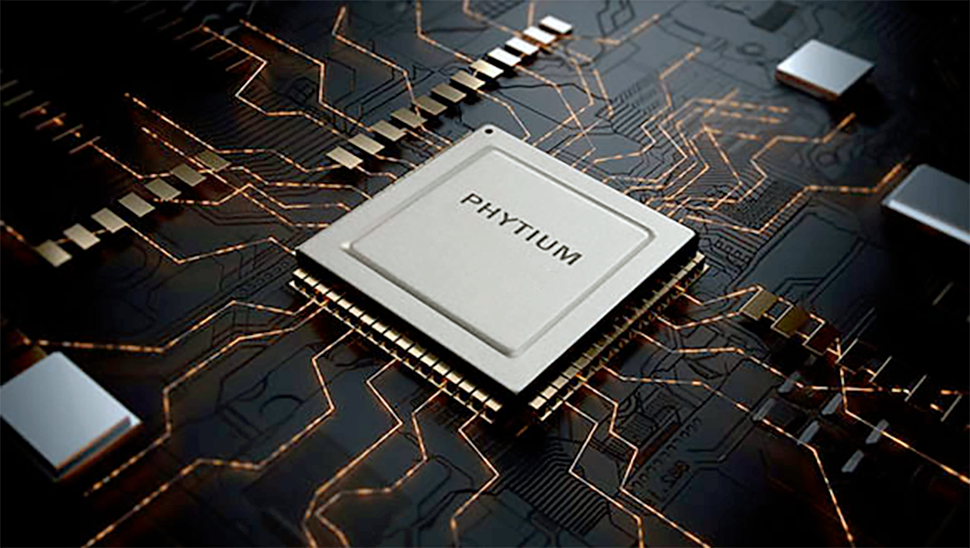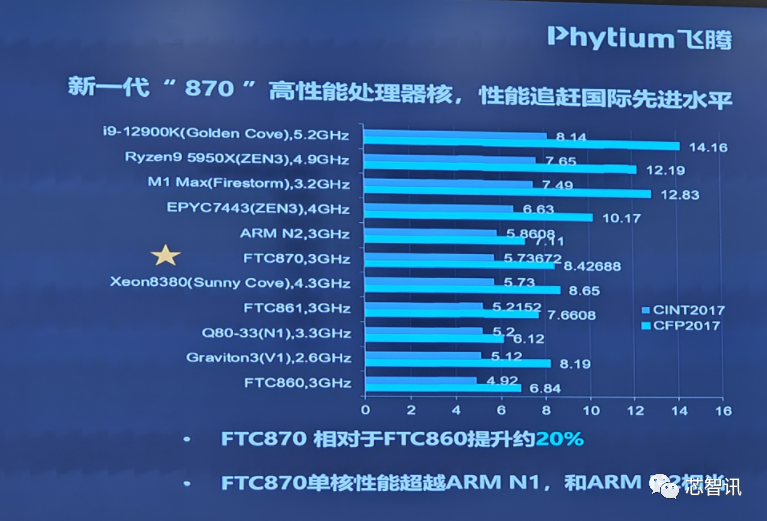Chinese Phytium's New CPU Claimed To Rival Arm's Neoverse N2
Phytium's FTC870 core can compete against Arm's Neoverse N2 core, according to the company.

Phytium has unveiled its latest high-performance processor core, FTC870, at the 2023 Malanshan Integrated Circuit Application Innovation Forum. The company claims that its FTC870 can rival Arm's Neoverse N2 cores in CINT2017 and CFP2017 benchmarks, according to ICSmart. This is a significant achievement for Phytium, which cannot access technologies developed in the USA due to U.S. government sanctions.
Phytium's FTC870 clocked at 3.0 GHz scores 5.73672 points in CINT2017 (a benchmark that tests the integer performance of CPUs) and 8.42688 points in CFP2017 (a benchmark that tests floating point performance of CPUs). By contrast, Arm's Neoverse N2 at 3.0 GHz hits 5.8608 points in CINT2017 and 7.11 points in CFP2017, whereas Intel's Xeon Scalable 8380 scores 5.73 points in CINT2017 as well as 8.65 points in CFP2017. Keep in mind that we are dealing with performance numbers from the company itself, so take them with a grain of salt.
FTC870 is Phytium's top-of-the-range offering for high-performance CPUs aimed at servers and desktops. By contrast, Arm's Neoverse N2 is the company's core aimed at edge and cloud servers. For high-performance computing (HPC), Arm has Neoverse V-series cores, which cannot be licensed to Chinese companies due to restrictions imposed by the U.S. government concerning performance. Meanwhile, it would be logical for Phytium to compare performance of its FTC870 to that of Neoverse V-series, though Phytium is also prepping more capable FTC871 core.
Phytium was added to the U.S. Department of Commerce's Entity List in 2021 and since then it cannot access advanced American technologies, including Arm's CPU cores that are designed (and manufactured) using technologies that originate from the U.S. Despite facing developmental hurdles because of the U.S. restrictions, the new core demonstrates remarkable advancement showcasing performance levels that rival and even surpass Arm's Neoverse N2 core.
Yet, it has taken Phytium over two years to develop its FTC870, so it remains to be seen whether the company can release new CPUs fast enough to stay competitive against its rivals.
Get Tom's Hardware's best news and in-depth reviews, straight to your inbox.

Anton Shilov is a contributing writer at Tom’s Hardware. Over the past couple of decades, he has covered everything from CPUs and GPUs to supercomputers and from modern process technologies and latest fab tools to high-tech industry trends.
-
bit_user So, it seems like these cores are implementing ARMv8-A.Reply
Keeping in mind that this announcement is of the FTC870, here's what the original article says (via Google Translate):
"Originally, according to the plan, Feiteng would launch the Tengyun S5000 series based on the FTC860 self-developed core of the ARMv8.2 instruction set architecture in the third quarter of 2021, with up to 80 cores, 1MB of L1 cache per core, and 64MB of shared L3 cache. It supports eighth-channel DDR5-4800 memory, 64-channel PCIe5.0, dual-channel/four-channel parallel, etc., and its performance is said to be comparable to Intel Xeon Platinum 8280."
They didn't say anything about how this new core is expected to be used, nor what process node it's made on. They did mention that, in mid-2020, they were using 16 nm.
BTW, if anyone has more information on these benchmarks they ran, I'd be interested to hear it. -
jp7189 Reply
1MB of L1 per core?! That would be 80MB L1 for the proposed CPU. They must mean L2.bit_user said:So, it seems like these cores are implementing ARMv8-A.
Keeping in mind that this announcement is of the FTC870, here's what the original article says (via Google Translate):
"Originally, according to the plan, Feiteng would launch the Tengyun S5000 series based on the FTC860 self-developed core of the ARMv8.2 instruction set architecture in the third quarter of 2021, with up to 80 cores, 1MB of L1 cache per core, and 64MB of shared L3 cache. It supports eighth-channel DDR5-4800 memory, 64-channel PCIe5.0, dual-channel/four-channel parallel, etc., and its performance is said to be comparable to Intel Xeon Platinum 8280."
They didn't say anything about how this new core is expected to be used, nor what process node it's made on. They did mention that, in mid-2020, they were using 16 nm.
BTW, if anyone has more information on these benchmarks they ran, I'd be interested to hear it. -
bit_user Reply
Yeah, agreed. Not only would the sizes make more sense, but it's also weird to jump straight from L1 to L3, saying nothing about L2. Plus, L1 cache is often segmented and not publicized as widely (but it's not hard to find stats on how big everyone's is).jp7189 said:1MB of L1 per core?! That would be 80MB L1 for the proposed CPU. They must mean L2.
